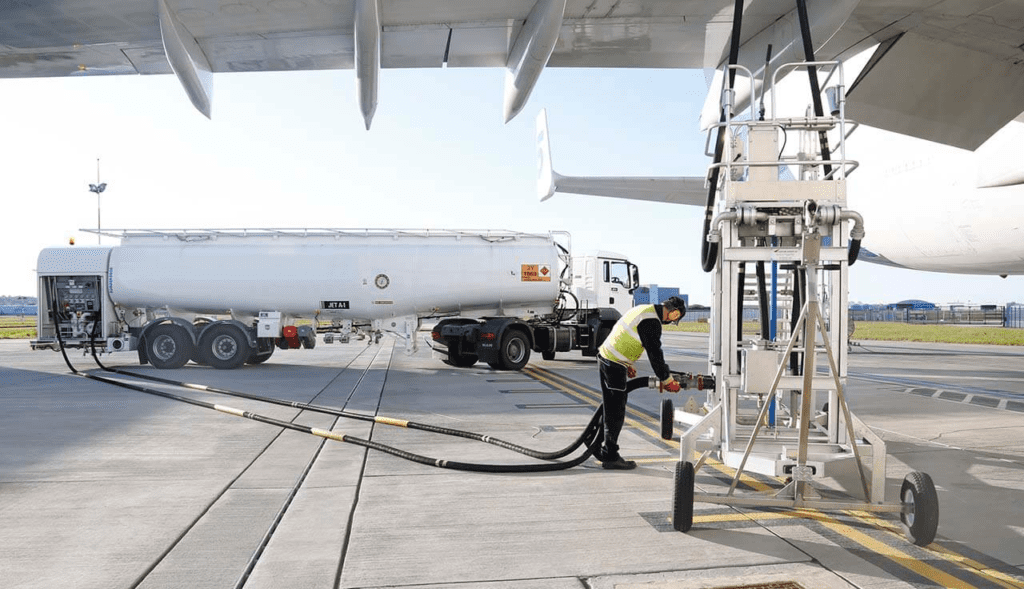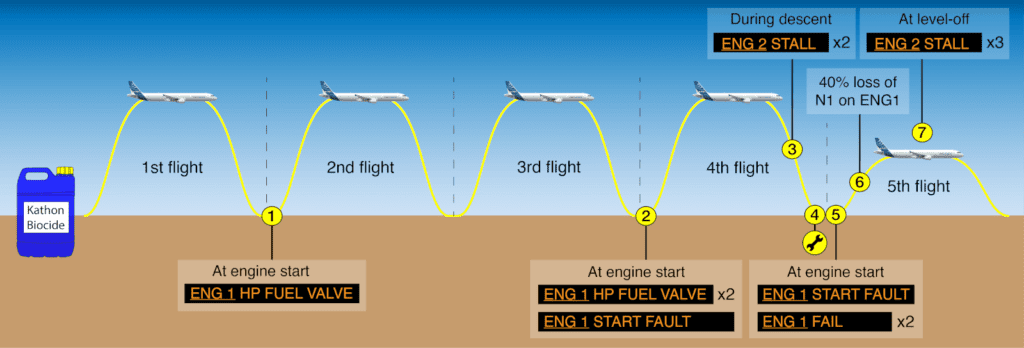
An aircraft fuel tank provides the perfect conditions for microbiological contamination to develop, especially when operating in hot and humid environments. Problems caused by microbiological contamination of fuel can range from inaccurate or erroneous fuel quantity readings to structural corrosion and engine fuel supply difficulties caused by clogged fuel filters.
As a result, if treatment is not correctly applied, microbiological contamination can also cause significant safety issues. This article describes why prevention is important and focuses on why it is essential to follow the maintenance procedures when treatment is required.

WHAT IS MICROBIOLOGICAL CONTAMINATION?
Microbiological contamination refers to the presence of microorganisms such as bacteria, yeast, or fungi. It can be seen as deposits, which vary in color from translucent to dark, with a viscosity that ranges from oily gel to solid.

Effects of fuel microbiological contamination
Erroneous fuel quantity measurement
Fuel microbiological contamination can affect the measurement of fuel quantity on board the aircraft. This can result in the flight crew observing false fuel quantity indications, which are often overreads. In extreme cases, these can lead to the total loss of fuel quantity indication for one or several fuel tanks.
Fuel filter clogging, pump failure, and engine malfunction
Deposits from contamination can clog fuel pumps and engine fuel filters, leading to fuel pump failures and degradation in the engine fuel supply.
Corrosion
Microorganisms can sometimes emit acid that causes corrosion, affects coatings, and deteriorates sealants in the fuel tank, which can eventually lead to fuel leaks.
Prevention is essential
As stated above, microbiological contamination can cause significant operational disruptions, which can affect the safety and efficiency of operations. An effective maintenance strategy needs to be developed to prevent contamination. Regular drainage of water from fuel tanks is necessary, even if the fuel system on Airbus aircraft is designed to manage and reduce the quantity of water in the fuel tanks. Regular tests to check for the presence of microorganisms are also crucial. If contamination is detected, curative treatment must be used.
CASE STUDY
Event Description
Before the event flight
A moderate level of fuel microbiological contamination was detected during scheduled maintenance checks of an Airbus A321 aircraft. As recommended in the Aircraft Maintenance Manual (AMM), a biocide curative treatment was performed using Kathon® FP 1.5 biocide.
Following the biocide treatment, there were four flights before the event occurred on the fifth flight (fig.1). The first flight was uneventful. ① On the second flight, the ENG 1 HP FUEL VALVE ECAM alert triggered, but ENG 1 start was successful on the second attempt. The third flight was uneventful. ② On the fourth flight, it took four attempts to successfully start ENG 1 with the reappearance of the ENG 1 HP FUEL VALVE ECAM alert and the ENG 1 START FAULT alert. This led to an automatic restart. ③ The ENG 2 STALL ECAM alert triggered twice during the descent and the flight crew felt airframe vibrations. They reduced N1 below 50 % and safely landed the aircraft.

④ Line maintenance performed the troubleshooting actions related to the ENG 2 STALL ECAM alert, but they could not confirm the fault. They released the aircraft back into service.
The event on the fifth flight
⑤ During ENG 1 start, theENG 1START FAULT ECAM alert triggered. The second start attempt generated the ENG 1 FAIL ECAM alert. This ENG 1 FAIL alert briefly appeared on the third attempt, but quickly disappeared and the ENG 1 start was finally successful. All engine parameters were normal during the taxi. At the runway holding point, the flight crew accelerated the engines twice for more than 10 seconds. All engine parameters were normal and the flight crew decided to take off.
⑥ ENG 1 began to surge at 500 ft RA and the engine parameters were fluctuating. N1 decreased below 40 % for 25 seconds. The Captain made a MAYDAY call and asked for an immediate return to the runway. He switched off the AP and noticed that the engine parameters of ENG 2 were also beginning to fluctuate. ⑦ During the level-off at 3 600 ft, the ENG 2 STALL ECAM alert triggered three times. The Captain reduced the thrust on both engines and was prepared to glide the aircraft, if necessary. The aircraft eventually landed safely. It was observed that the engine parameters had returned to normal when the aircraft came to a complete stop. The flight crew reported that they shut down both engines on the taxiway when they heard unusual noises from the engines.
analysis
The fuel from the aircraft showed contamination and an amount of undissolved Kathon® FP 1.5 biocide. An inspection of the engine found the presence of viscous, gelatinous deposits on the engine parts.
Source – Airbus





